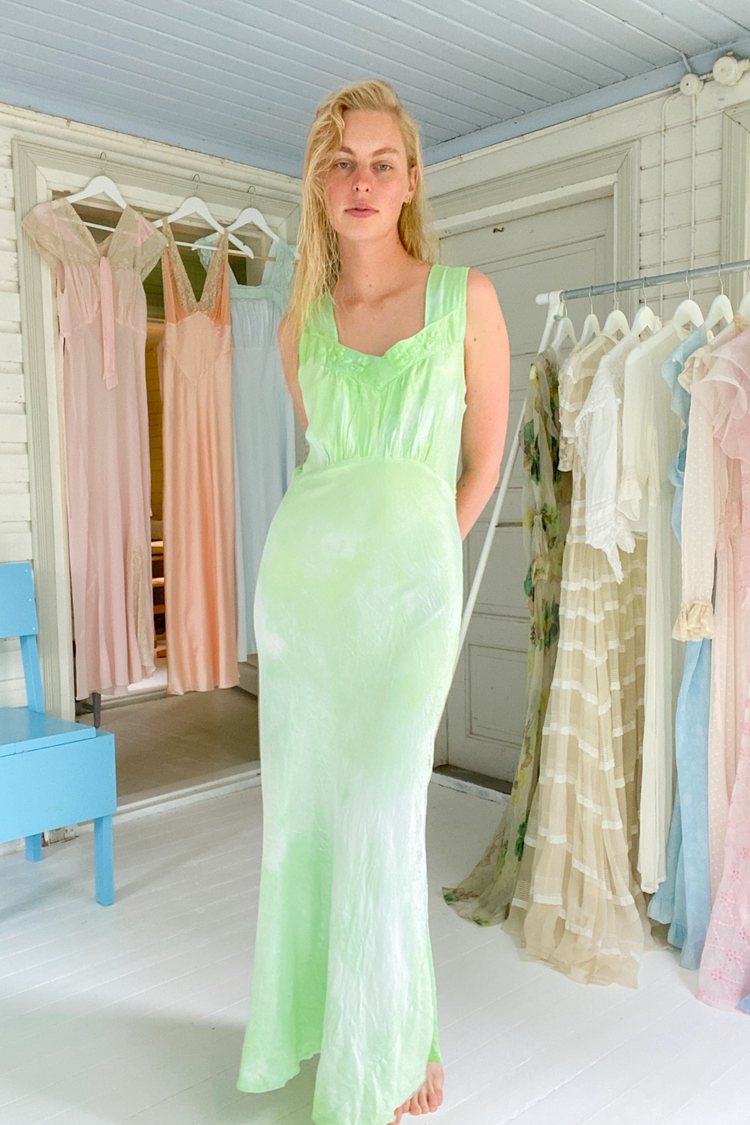
30s Gowns Then and Now
Miami-based Eveliina Vintage is known for their dreamy 30s dresses. Founder Eeva Musacchia explains how the dresses were worn back in the days and how they are worn now.
“A few years ago feminine, light, and romantic style became the fashion. Young customers discovered pastel colors and floral prints. And as 30s dresses have all those attributes, they became hugely popular and coveted.
All in all, 30s dresses were very feminine, even princess-like. Dresses often had little puff sleeves, exaggerated shoulders (even paddings), sweetheart necklines, deep open backs, and sometimes evening dresses had little trains at the back. Fabric flowers, velvet trimmings, and ruching were typical decorations. There were also a lot of bows in all shapes and forms.
The silhouette was very specific: fitted at the waist, long and slim. Bias cut was popular because it makes the body look extra slim.
The 30s loved beautiful colors: there were canary yellows, oranges, blues, greens. Small-scale florals and plaids were popular prints.
Fabrics were very light: silks, chiffons, satins, crepe de chines. Day dresses were made of cotton as it was easier to take care of. Especially the evening dresses were very high-maintenance: the fabrics were delicate and required hand-washing as washing machines became common first in the 50s. Also ironing the dresses required a lot of time, handwork, and skills.
Most 30s day dresses were still made at home; evening dresses were oftentimes made-to-order. Every 30s dress involves hours of handwork; even undergarments were richly decorated and embroidered. A lot of women did the embroidery evenings at the home when they were finished with other tasks. Vintage dresses tell about the history of women.
In the 30s, housecoats became popular: simple garments women only wore at home. Although they were not meant to be seen outside the home, they followed the trends in cut and silhouette. These dresses are so popular now. Many designers were looking for 30s house coats last season. They are an easy way to add a touch of personality to everyday wardrobe and they often have great prints, easy fit, and made of a material that is relatively low-maintenance.
In the 30s, dresses were usually worn with a separate slip or the dress itself had a lining to hide the underwear. Corsets were still used as women wanted to emphasize their waistlines.
Nowadays, these vintage dresses are often worn without a slip – underwear can show. Or a 30s undergarment is worn as a dress. Underwear has become an outer garment and you can sleep and party in the same dress!
Sometimes our customers like to wear a 30s dress backward: the deep open back is in the front. In winter, they style these dresses with sweaters and jeans.
30s dresses need to be hand-washed. They are all made of natural materials like silk and cotton which stand washing in water. The colors turn out much brighter when you wash in the water versus when dry-cleaning! If there are stains, put some detergent just on the stain, let it sit in water, and see what comes off. Always dry the dress flat on a towel and dry it outside if possible to get a fresh smell of laundry.
I try to use mild and nature-friendly detergent. Always make sure to try first a small sample for color run. In case of a color run, use dry cleaning.
In the 30s women still lived by the fashion seasons. They bought new pieces for spring, summer, fall, and winter. Women saved and wore all their clothes much longer than we do nowadays. For that reason, they took very good care of their clothes. When wanting to let go they passed their dresses to younger women in family and relatives.”





